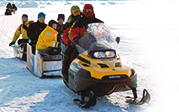The White sea
THE WHITE SEA is one of the most beautiful among the seas of Northern Russia. Being a part of Russia’s inland sea, it belongs to the Arctic Ocean basin. The White Sea contains a large number of islands, but most of them are small. Velikiy Island, located close to the shore, is the largest island in the Kandalaksha Gulf.
The nature here is untouched by man, and the local wildlife is rich and unique. In summer birds team-up on uninhabited islands to hatch eggs and rear their chicks. Every winter Greenland seals make their rookeries in the northern part of the White Sea and their calves are born there. The sea is also a home to White whales.
Landscapes and Scenery
The deserted seashores and numerous uninhabited islands provide scenic panoramas. Steep rocky shores are alternated with flat strips of taiga and mixed forest.
The underwater wildlife
The underwater world of the White Sea boasts excellent scenery and fascinating marine life. A diver can see soft corals, sponges, starfish, crabs, hermit crabs, sea urchins, shrimps and sea anemones. Underwater rocks provide dwelling places for cod, wolffish, sea perch, butterfish and flounder. In winter wolffish, flounder and lumpfish allow divers come really close.
Climate
The climate of the White Sea territory varies between polar and moderate continental with frequent fogs and clouds. The weather is very changeable and unpredictable as it is influenced by the continental and maritime air masses’ movement.
The White Sea winter is long and severe. The mean temperature in February is -15°C over most of the sea, but it may rise up to -6°C due to the warm air masses from the Atlantic, while Arctic anticyclones may bring much colder weather with temperatures of about −25 °C and even -40°C.
In winter, from November-December till April-May, the sea freezes, with the average January water temperatures of −1.9 °C in the north, between −1.3 and −1.7 °С in the centre, and between −0.5 and −0.7 °С in the bays. At depth it may drop down to -3°C. The gemeral water salinity is about 27,5-28% and increases across the sea from 24–26% in the centre to 30.5% in the gorlo, reaching 34.0–34.5% toward the Barents Sea. The freezing period varies from year to year. The ice is not stationary, but 90% of it is floating and is continuously removed to the Barents Sea. Ice thickness is usually about 40 cm but may reach 150 cm in cold winters.
Summers are rather cool, cloudy and relatively humid, with north-eastern winds and frequent rains. Mean July temperatures are +8-12°C, though south-eastern winds may bring warm air from Europe, raising the temperature to +17-19°C and sometimes even to 30°C.
In summer, the surface water temperature reaches 13-16°C, the warm water layer thickness is about 15m., at this depth an abrupt temperature drop takes place (to +1-0°C at 25-30m. depth) followed by gradual temperature decrease so that -1.4°C may be observed at horizons of 100m and deeper.
Water visibility ranges from 10-20m. in summer to 15–50m. in winter season.
Tides are regular and semi-diurnal. Tide speed varies from 0.1 to 4 m/sec.
Latest updates

Dog fitness



